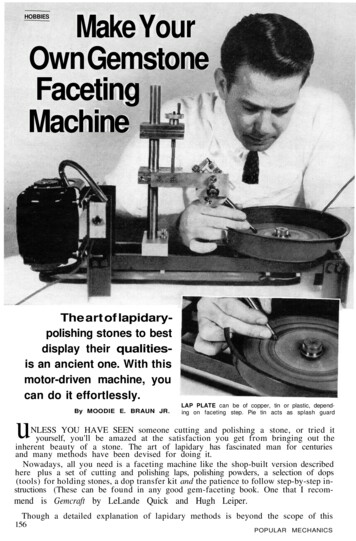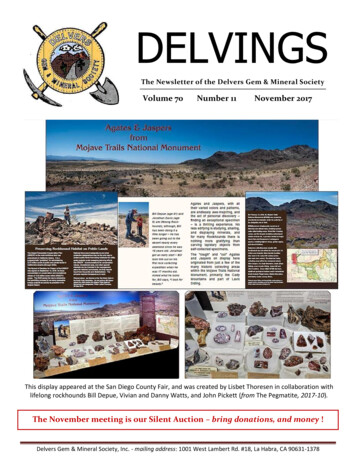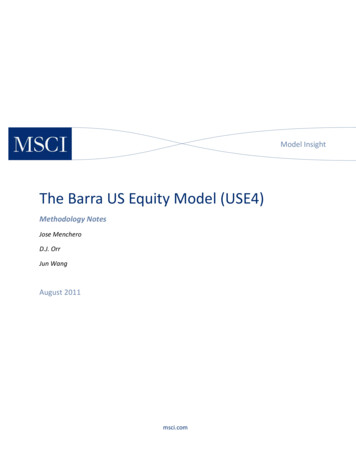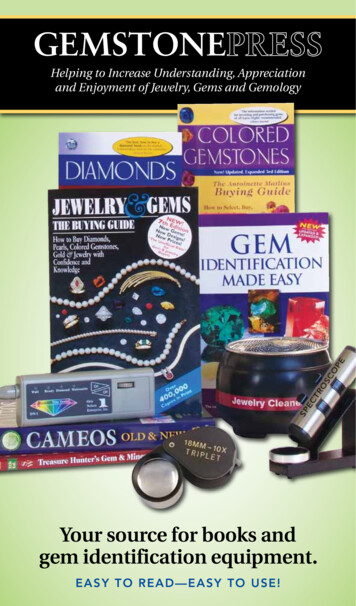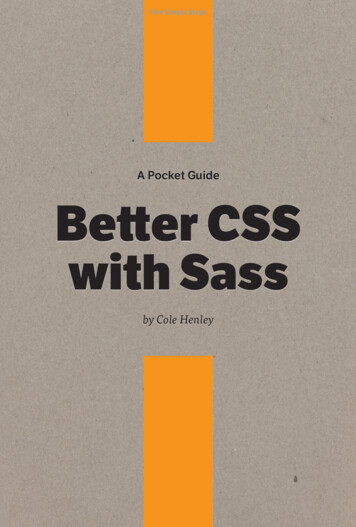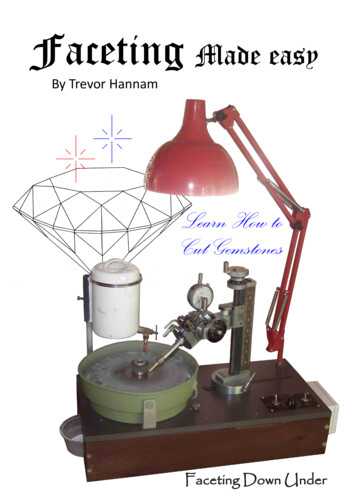
Transcription
Faceting Made easyBy Trevor HannamLearn How toCut GemstonesFaceting Down Under
The Beginners GuideOnFaceting GemstonesCopyright 2000 Trevor G. Hannam4th editionAll rights reserved - No part of this book or associated DVDMay be reproduced in any form, without the written permission from the author.Trevor G. Hannam, 1 Glenwood Close., Atherton, QLD 4883PH: 4091 1966Should you require a copy of the book or the DVDplease contact the following:Trevor G. Hannam, 1 Glenwood Close., Atherton, QLD 4883PH: 4091 1966Pages that are damaged through some mishap can bere-supplied @ 3.00 per page Copyright 2000Trevor G. HannamPage 2
HINTRODUCTIONave you ever read a book filled with so much technical jargon that it leaves youmore confused than when you started! I think we have all fallen into this category one time or another.It is for this reason that this book has been written. I myself found learning from such abook, if not properly illustrated or explained in everyday terms can be very frustrating anddiscouraging. Unless you can get an instructor to help you, most beginners will just give itup.This book and associated DVD (if purchased) contains detailed instructions and illustrationsin concise patterns on cutting the Standard Brilliant, and gives the individual a workingknowledge of all parts of the Faceting Machine.Books and teachers of faceting often vary in their technique and most still advocate cuttingthe table first. Times change, and new ways are found to cutting the Standard Brilliant.This book just presents faceting another way, starting with the pavilion and as you readand learn, you will see the wisdom of this technique.There is no hard and fast rule in faceting, just the basics and beginners are encouraged toexperiment once they have mastered the Standard Brilliant.I feel this book has presented gem faceting in such a way that any average person can learnquickly, and soon develop their own technique in the art of gem cutting.Trevor Hannam2000ABOUTtheAUTHORTrevor G. Hannam, born in Wudinna South Australia, moved to Cairns Queensland 1966. Introduced to faceting by Kay & Jimmy Gadd, where helearned to facet with the help of Bob Johnson.Furthered the study of gems by completing a diploma in ‘Earth Science’, and continued to studythe art of ‘Gemmology’ through kye Jewellers. Member of the 'CairnsMineral & Lapidary Club Inc.' where he use to teach the art of silversmithing , Gemmology techniques and faceting. Currently Retired. Copyright 2000Trevor G. HannamPage 3
CONTENTSCHAPTER 1Light and its PropertiesPage 5CHAPTER 2Faceting MachinePage 11CHAPTER 3Faceting EquipmentPage 16CHAPTER 4Preparing Polishing LapsPage 20CHAPTER 5Selecting RoughPage 21CHAPTER 6The Standard BrilliantPage 23CHAPTER 7DoppingPage 24CHAPTER 8RoundingPage 26CHAPTER 9Cutting the PavilionPage 29CHAPTER 10PolishingPage 32CHAPTER 11TransferringPage 37CHAPTER 12Cutting the CrownPage 42CHAPTER 13Cutting Angles for different MineralsPage 49DESIGN CUTSEmerald CutPage 51Spidery CutPage 52Ollen CutPage 53Champagne GlassPage 54Kaytre CutPage 56Kaytre No5 CutPage 57ReferencesPage 58 Copyright 2000Trevor G. HannamPage 4
CHAPTER 1 - LIGHT & ITS PROPERTIESSpeed of light Travels through air and space at 297,600 kilometres per second, but as itpasses through a solid object, such as a piece of glass, it does two things, slows downand changes direction or bends.Why does light slow down? Because it’s passing through a denser material than air.For example, try driving a car through water. The water is more dense than the air, so weare slowed down by it.Why does light bend? As light tries to pass through the glass it is pulled due to thesudden reduction of speed, because of the higher density. Lets take for example, that weare driving on a sealed road and up ahead there is a small amount of water on the left handside of the road. As we hit this water at normal speed, the vehicle is immediately sloweddown and pulled to the left. This is exactly what happens when light passes through glass.This phenomenon is known as Refraction and is constant in all gem stones.REFRACTIVE INDEXIs the speed of light divided by the speed of light in the mineral concernedSINGLE REFRACTIVELight PathLight PathRefraction297,600 Km/Sec177,600 Km/Sec297,600 Km/SecLight PathIn Calcite Crystals and some otherminerals light has the tendency tosplit into two paths. This is known asDouble Refraction.DOUBLE REFRACTIVELight PathRefractionLight Path Copyright 2000Trevor G. HannamPage 5
When a gem is cut properly with angles that are designed for it, the gem will causelight to be internally reflected many times and thence returned through the table to youreyes. It is the internal reflection and refraction which produces the little explosions of colour. The facets actually acting as tiny prisms.White light breaks down readily if passed through a prism into the colours of a rainbow. As a kid I was taught this as a name; ‘Roy G. Biv’ - Red, Orange, Yellow, Green, Blue,Indigo and letLight RayGlass PrismTHIS PHENOMENA IS KNOWN AS DISPERSIONDOUBLE REFRACTIONLight can be affected in other ways in a crystal. Minerals can either be single refractive ordouble refractive. In normal single refractive minerals, light behaves in its normal manner,that is, it slows down, refracts and is internally reflected. In double refractive minerals, thishowever is altered. Light is split up into two paths. This is due to the minerals atomic structure and its having one or two axis's of different lengths.Calcite is a very good example of double refraction. If you place a piece of clear calciteover some small print, you will clearly see the print doubled, as if you have gone cross eyed.Original print showsUp as two sentences.Calcite CrystalDiagram showing Double RefractionIn a Calcite Crystal Copyright 2000Trevor G. HannamPage 6
POLARISCOPEDouble refractive minerals can easily be identified by using a Polariscope, which is definitely required by the amateur faceter if he or she is looking for the best optical benefits.A Polariscope consists of two discs of polarized plastic (or a cheap pair of Polaroid sunglasses) that are separated by a mechanical support. A light source is producedunderneath one of the discs. The gem rough is then placed atop of this disc, whilstyour eyes are looking through the top disc. The top disc is then turned until it reachesit darkest point. The stone is then turned or rotated in a 360 Degrees revolution in alldirections until you see the best position of refraction. What you see as the gem isturned is a lightness and darkness of the polarized light. Will be either 2 times for adouble refractive stone (known as uniaxial) or 4 times for a stone with a double axis ofdouble refractive stone (Known as biaxial). The axis of the stone or gem rough is thepart where the gem turns the least amount of light and dark.Below is the principal of a Polariscope.General Diagram of use of a PolariscopePolarized disc when 90 Degreesout of phase. Produces the darkest area. This is the correct position for viewing. The Polariscopeis a must for double refractivestones, such as, Zircon and Peridot.Blue ZirconDirection ofDouble RefractionLight Source Copyright 2000Trevor G. HannamPage 7
THE CRITICAL ANGLEAs the angle of light from a source increases to the surface of a gem stone, the angle of refraction will also increase until a point is reached where it will run parallel with the surfaceof the gem stone. The angle of incidence which causes the light to become parallel to thesurface is known as the Critical Angle.If the angle of light exceeds the critical angle, the light source will become totally reflected. The minerals with a small critical angle will loose less light than ones that have alarger critical angle. This means that gem stones with a smaller critical angle can prolongthe internal reflection of light thus producing more sparkle and colour.WHAT LIGHT DOES WHEN THE ANGLE OF INCIDENCE IS INCREASEDPartial RefractionPartial RefractionIncreasing AngleLight runs parallelwith the surfaceCriticalAngleCritical AngleExceeded causingTotal reflectionTotal ReflectionPartial RefractionPartial Refraction Copyright 2000Trevor G. HannamPage 8
CUTTING OF CORRECT ANGLES AND WHAT CAN HAPPENIF THE ANGLES ARE NOT CORRECT FOR THE MINERALCONCERNEDTOPAZ CRITICAL ANGLE 37ºCut from 39 to 42ºAngle 42ºThis gem stone has been cut correctlyThe angles are correct for the mineralTopaz and has full total reflectionwhich produces those little explosionsof colour.This gemstone has a dark centre and iscaused by excessive leakage of lightthrough the pavilion because it hasbeen cut at an excessive angle of 50Degrees.Angle 35º Copyright 2000Trevor G. HannamAngle 50ºThis gemstone has what is known as a ‘Fisheye’ effect, and is indicated by seeingstraight through the centre of the gem stoneproducing a halo appearance around the perimeter. This is caused by cutting the gemstone far to shallow, 35 Degrees.Page 9
PLEOCHROISMCertain minerals have a colour change which is caused by absorption of light when it passesthrough different directions in the mineral.If you turn a gem and see different colours from different directions, the mineral isreferred to as being Dichroic. A good example of this would be a sapphire. If looked straightdown upon the crystal, that is its ‘C’ axis, the gem will appear to be blue, but if looked at 90Degrees or side on the crystal will appear green.The gem Iolite also shows this phenomenon, but has three colour changes. Blue,clear, and yellowish.An instrument used for viewing this effect (dichroism), is called a Dichroscope, and ismade from a piece of clear calcite and a lens situated in a small tube.SAPPHIRE CRYSTAL SHOWING PLEOCHROISMBlueGreen‘C’ Axis Copyright 2000Trevor G. HannamPage 10
CHAPTER 2 - HALLS MKII FACETING MACHINELight 40WCoarse HeightAdjusterAdjustableMicro HeightAdjusterAngle CheaterStop IndicatorPostDial GaugeSpeed ControlWater ReservoirControl BoxCoarse AngleAdjusterProtractorAngle StopIndex CheaterIndex WheelQuill - Dop ArmWater SpiggitValveChuckMaster LapDop StickNutSwarf TrayRemember, with any machine, no matter how good it is, will not be as goodas your eyes. The old saying “CUT A LITTLE LOOK A LOT” always apply. Copyright 2000Trevor G. HannamPage 11
ULTRA TECH FACETING MACHINE40 Watt LampWater Reservoir& ValveCoarse/Micro HeightAdjusterDial GaugeAngle CheaterIndex Changer& Free WheelIndex CheaterNutProtractorPost LockPostSpeed ControlDiamond LapSwarf TrayIndex WheelQuill - Dop StickSwarf WasteTraySet of Dop Sticks&Transfer Jig Copyright 2000Trevor G. HannamPage 12
Dial GaugeIndex Free WheelLever & LockAngle Cheaterand StopProtractorIndex CheaterMaster LapSpeed ControllerSet - 0RoundingPost12VDCMotorMicro HeightAdjusterSwivel JointIndexWheelCourse Height AdjustQuill - Dop StickSwarf TrayIndexCheaterCAMPER SERIES FACETING MACHINEPostIndex Release ProtractorLever & LockAngleStop LockMicroHeight AdjustWaterVesselCoarseHeight AdjustIndexWheelPostQuillMaster LapMotorSpeedControlNutSwarf TrayPost LockTransfer JigGEM MASTER G1Indicator Stop Lamp Copyright 2000Trevor G. HannamPage 13
TERMINOLOGY Quill & Alignment ToolThe quill or dop arm as it is sometimes called, houses themounted dop stick, and is attached to the toothed gear known asSmall Set Screwthe index wheel. This quill has either a self centre chuck or a smallset screw to lock the dop stick in position.Some machines do not have alignment notches built into the quillor transfer Jig, and alignment tools makes life easier for aligningfacets between the Crown and Pavilion. A good machine shouldQuill with Dop Stickhave at least one of these. The alignment tool allows for perfectrealignment, should you have to remove or replace the dop stick at any stage whilst cuttingor polishing. Index Wheel & CheaterThe index wheel is the large toothed gear and comes in a variety of indexes. Normally themachine will come with a 96, and/or a 48 index wheel as standard equipment. Theseindexes should be easily interchanged withoutIndex Wheel Releasedifficulty. If not - be wary!The index wheel can be released by pushing in thearm of the spring retainer so the quill can be moved ineither direction (as with most machines). This arm canbe locked into position so the index wheel, and quillcan turn in a 360 for rounding.A small amount of movement, either left or right of96 Index WheelIndex Cheater (showing No 2)the main setting is available by using the indexcheater. The cheater will allow for small errors in cutting or polishing, and normally willhave a centre mark to help you show direction (left or right) when cheating. Protractor, Stop & CheaterThe protractor is probably the most important part of the machine, and should have clearengraved half degree divisionsAngleCheaterwith a good marker, pointer orface that can be seen, and readfrom nearly all directions when innormal operation.The angle stop sets the quill to anyStopangle between 0 and 90 on theProtractor (Set at 60º)protractor, and should moveAngle Stop & Cheaterfreely between the stop, and theAngle Cheaterset angle. Most machines will incorporate a dial gauge and/or asmall indicator light to give the operator a warning when the stopis reached. The stop should be solid, and held firm by a lockingdevice so the quill cannot past this point.Located on the stop, may be an angle cheater, a small taperedshaft that can be screwed in or out to adjust the angle by the 10thdegree, but be prepared, there are a lot of machines out thereDial Gauge Fittedthat do not have an angle cheater, in fact most faceters will tellyou that the angle cheater is not necessary. Copyright 2000Trevor G. HannamPage 14
The Post & Coarse AdjusterThe post is the main support for the head assembly and is90 to the base plate. The post can be either fixed oradjustable along a slide that is fixed by a locking nut. On thispost, to which the head assembly is fitted, is a coarseadjuster. This is a large knurled knob which releases ortightens the head assembly to the post so the quill can beraised or lowered by hand (coarse adjustment). The micro Height AdjusterFitted to the head assembly or in some cases to the mainpost support. The micro heightCoarse & Micro HeightBase Assembly LockAdjuster 0.02mm IncrementsPull Handle Down to secure Post to Baseadjuster should be adjustablewithin a span of approximately 25mm, and is normally markedin graduated steps of 1 to 5 thou increments. Some machinesdo have micrometers fitted as part of their standardequipment. Water ReservoirA good reserve of water should beWater Containeravailable to the faceter. NormallyValve & Spoutall faceting machines will have areservoir fitted to the side of theMaster Lapswarf tray, and have a capacity ofRH Lock NutMain Post500 mils minimum. A stop valveshould be fitted to allow control over the water flow, and thecontainer should be able to be swung away from the lap whenrequired. Speed Control & MotorAll faceting machines must be driven by an electric motor ofUltratech Swarf Traysorts (or can be hand crank). This can be by either 240V or12/24 Volt, and is normally belt driven by stepped pulleys or variable speedcontrol.If a fixed 2 or 4 pole motor is used, then the faceting machine should befitted with a stepped pulley system so the speed can be changed manually. Agood speed for minimum is 100 rpm to around 1400 for fast speed.The best system is a variable speed system either in 240V, 12 or 24 Volt.Ultratech Speed Control12/24 Volt is preferable due to high torque and less noise.As mentioned earlier, all machines today can be considered a marvel of modernengineering. Some are better than others, and some offer more incentive by gimmicks, andattachments, but all in all, the faceter has to make the decision that suits him best. Themain criteria for any faceter is Ease of Operation when facing the machine in the standardcutting mode. Copyright 2000Trevor G. HannamPage 15
CHAPTER 3FACETING EQUIPMENT FACETING MACHINEShould include dop sticks, transfer jig, 45 degree angle dop and a flat dop. It seems thatquite a few faceting machine manufacturers don’t include flat dops in their kits. If you happen to be one of the unlucky ones, don’t despair, as a valve from an auto or bike shop willsuffice quite well. Just be sure that it has a 1/4” or 6 mm shank. Essential tools, such assmall spanners, screwdrivers and Allen keys are a must. LAPSA lap is a flat disc which is used to cut and polish gemstones. Today there is a multitude oflaps offered for sale, but non better than the good old copper lap. The copper lap has beenaround for many decades, makes an excellent pre-polish lap and is still preferred by manyexperienced faceters. These type of laps have to be charged with diamond powder, arecheap and easy to maintain.Metal bonded laps have diamond powder electroplated onto a thin copper disc which isglued to a master lap made of aluminium. These type of laps are more expensive than thecopper laps, but cut flat and true with good clean facet edges. I have found from experience, that the pre-polish lap do have a tendency to become dull very quickly and thereforeis not recommended for the beginner until he or she has gained more experience. Coarselaps on the other hand are a must for the faceter and will last an extremely long time andare well worth the few extra dollars to buy.Polishing laps also come in a variety of types, namely: Aluminium, brass, ceramic, Lucite,cast iron, iron, tin lead, type metal, and even timber, but one can’t surpass the ever populartin lead lap for polishing as an all round general purpose type. Used with 50,000 mesh diamond powder, it will outperform all other laps due to the metal’s ability to polish mostgemstones.LAPS REQUIRED(1) Coarse 100 to 180 grit disc grit metal bonded type - Used for quick removal(2) Coarse 220 to 300 grit metal bonded type(3) Pre-polish 1200 and/or 3000 Copper Lap(4) Polish Tin Lead lap - made from 60/40 solder or Type MetalOnce you have established yourself as a faceter, try experimenting with other laps. They allwork very well and you will find the aluminium lap extremely good for polishing sapphires.The ceramic lap gives clean flat sharp facet edges, and is best suited to gemstones of 8 inhardness. Not to be considered as a general purpose lap, but if you are considering enteringfaceting competitions, the laps superiority over soft laps must be well considered.Cast iron and iron laps can be considered a second best to the tin lead lap. They give agood crisp straight edge and are suitable for stones of 8 (Topaz & Sapphire) that can onlybe used with diamond powder and a good grade of olive oil. The laps coarseness or porosity of the metal makes it a good holder of polish powder. From experience, this lap can beconsidered to be on par with the ceramic lap, giving precise clean flat facets and is worthpersevering with until the lap is worn in. Copyright 2000Trevor G. HannamPage 16
The last one to mention is the Lucite lap. Made of plastic and is normally used withcerium or tin oxide powders mixed with water. This type of lap is generally used forpolishing Quartz, and requires the lap to be kept extremely wet while in use to preventheat build up and rounding of the facet edges. Quartz being one of the hardest minerals Ihave found to polish can be assisted by the use of a small amount of vinegar added to thepolish mixture. Using Lucite laps require a very slow speed. DIAMOND POWDERDiamond grit used for cutting and polishing of gems come in a variety of sizes, ranging from0.1 to 100 micron. The diamond powder that we use today is mostly made by man, and ismore consistent in particle size than natural stones which have been sieved by a screen.Grit sizes of 80 to 325 normally come in a powder form from 1 carat to 5 carat vials. Whilst600 mesh size and over can come in a variety of containers, vials,syringes and spray packs.To start, we will need 1 carat of each size, 1,200 mesh, 3,000 meshand 50,000 mesh. The 1,200 and 3,000 mesh are both the pre-polishgrade. 1,200 mesh is the all rounder for pre-polishing, whilst the 3,000mesh is recommended for doing sapphires as they suffer badly from‘Orange Peel’ or over cutting due to planes of softness within themineral. The 50,000 mesh is used for the polishing stages and is agood all round polish powder. You can however use 100,000 mesh forDiamond Productspolishing, but polishing of the facets will take a little longer. It has100 Thousand Spray BottleSyringes - 14,000 & 50,000been my experience that there is virtually no difference between220 & 50,000 Mesh in1 carat & 5 carat vialsthese polishing powders when it comes to viewing the finishedproduct. ADHESIVES5 minute/24 hour epoxies and super glues (cyanoacrylate) are an added advantage when itcomes to faceting and all faceters should have in their arsenal, Loctite 416 Super glue,Epoxy adhesive such as ‘Tite On’/JB Weld and a small tube of 5 minute araldite. Copyright 2000Trevor G. HannamPage 17
DOP HELPA small container of dop help which you can buy direct from any good lapidaries supplier oryou can make your own.Made from shellac flakes and methylated spirits. The shellac flakes can be bought frompaint suppliers or any good hardware store. Using a small glass container that has a tightfitting lid, such as a Promite container - half fill with shellac flakes and pour methylated spirits onto the top until the container is full. Shake this container vigorously for a few minutesonce every day for 3 days and then let settle for a couple of days. Pour of the top part ofthe liquid into a small vial etc. This makes an excellent dopping media for faceters wax, inexpensive and will last you for years. DOP STICK HOLDERA must for beginners or any enthusiasts, 3 or 4 dop stick holders. Made from a 1” broomhandle. Don’t use the wife’s broom for this venture or you may very well end up in the dogshouse. Cut 3 or more pieces from your broom handle approximately 30mm long and drill a1/4” hole in the centre to a depth of around 15mm. These essential pieces of equipmentwill be required to hold your dop sticks in an upright position for gluing, fixing and handlingyour gem stones especially when using hot wax. FACETING WAXFaceters dopping wax is made from a mixture of Shellac flakes and red Ceiling wax. Doppingwith wax has been around since ‘God was a little boy’, and is still regarded as the all purpose adhesives for gem faceting. Normally faceting wax comes in a bundle five to six sticksper pack and is relatively cheap to purchase. Occasionally green wax can also be used but isa lot softer and can cause shifting of the stone whilst polishing due to heat build up. HEAD LOUPEA small head loupe of 3 1/4 power and/or a 5 to 10 power eye piece, preferably one that iscorrected, so there is no distortion of the outer rim when viewing an object. A good lensthat can be purchased cheaply, is an eye piece from a pair of binoculars (7X50 or 10X50).You can pick these up at second hand markets etc, and they work extremely well. KNIFEAny small knife will be fine to use. This will have to be dedicated to the job, as the blade willbe used for heating, scraping, mixing and applying adhesives. OLIVE OIL & Polish ExtenderCooking grade olive oil will do fine. This oil is used as a coating to hold and distribute thediamond powder onto your pre-polish and polish laps.When mixed with Shellite (1 part of olive oil to 40 parts Shellite), you create an excellentcutting oil extender for both the pre-polish and polish laps. Also, makes a very good cleanerfor the laps. Pour the extender into a small spray bottle (50 Mil), as it will give a better coverage.Beware of Naked Flames & Use Common Sense Copyright 2000Trevor G. HannamPage 18
OVENOVENA medium size jam tin that is cut out to suit your spirit lampto be used as a hot plate. Used for slowly heating your gemrough to accept dopping wax to transfer onto the dop sticks REFRACTOLAvailable from any good lapidaries suppliers, and is a mustto the amateur faceter for seeing imperfections within apiece of rough. This oil has a refractive index close to midrange of most minerals, approximately 1.57. When this oil isapplied (with a small fine artist brush) to the gem rough, itmakes the surface extremely clear. Just like a piece of glass,Spirit Burnermaking it easier to view inclusions. You can also purchasefrom a chemist some Clove and Cinnamon oil, as these haverefractive indexes 1.54 and 1.62 respectively and will help you view gem rough that havelower and higher than 1.57. SPIRIT LAMPAlmost any type of burner or even a candle will work as a flame heater for heating wax andtransferring, but you will find the alcohol lamp (as viewed above in a home made oven) willbe your best bet, namely because of its a clean flame and heating ability compared to someother types. VERNIERS & SCALESA good pair of metric plastic vernier/callipers with dialgauge to measure gem stones, a must if you consider going into competitions. Callipers can be expensive or cheap- its best to get a good pair if possible, though I must admit in the end the pocket will decide the quality.Not essential, but advantageous is a set of scales forweighing your finished gem stones. The scales will needto be able to weigh as low as .001 carat (there is 5 caratsto 1 gram). 1.2.3.4.MISCELLANEOUSSoft tissues: The best to use here is soft Sorbent toiletrolls, and it is a good idea to fix a toilet roll holder closeat hand when faceting.Methylated Spirits and or Acetone make a good a cleanerfor dop sticks and cleaning of super glues etc.Pen and Paper: Always keep at hand to write down information when faceting. Don’t try to rely on memory,notes can always be referred to when required.A small 4” trim saw would be a good investment, but canbe done without as most stones can be cut directly fromthe rough. A small mandrel can be made by an engineerto take a small blade on the faceting machine. This then is used to cut the mains ofthe stone, thus saving the expensive laps. Copyright 2000Trevor G. HannamPage 19
CHAPTER 4PREPARING A PRE-POLISH LAP PRE-POLISH LAPMaking up your pre-polish lap is very easy. Using anew copper lap, clean the surface with a tissuewith the extender fluid. Place a couple of drops ofolive oil on your lap, and with a clean tissue wipe itall over the lap until it is almost dry. You will needthe vial of 1200 mesh diamond powder (pre-polishpowder). Wipe a clean finger over the lap, this willleave a smear of oil on it. Open the 1200 mesh diamond powder, place the index finger over the topand invert. Invert back again and lift the finger offthe vial. You will now see a grey coating of powderon your finger. Place your finger in different spotsover the lap, and then spread the powder as evenly as possible over the laps surface with your finger.The lap is now prepared, and will last a long time before the lap will need resurfacing withdiamond powder.Placing powder on thelap using a clean fingerPreparing your Copperlap for pre-polishingPre-polishCopper lapSpreading the meshPowder over the lap Copyright 2000Trevor G. HannamPage 20
CHAPTER 5SELECTING THE ROUGHAs we are a beginner, lets start with a piece of topaz. Topaz has a good relative hardness, has good refractive index, is nice and cheap and will produce a gemstone ofsparkling brilliance. CLARITY - clearnessYou have a piece of topaz that isn’t a piece of crystal, but has been water worn and is impossible to see through. Wetting this with water will help, but not enough to be able to seethe inclusions and flaws etc. This is due to the refractive index (RI) of the water (1.33) notbeing high enough. To be able to view inside readily we need to use a liquid close to the RIof topaz (1.63). The use of the refractol will do just that (or cinnamon oil). Paint this overthe stone with an artist brush and you will be able to see right through the stone as if itwere a piece of glass.Look hard into the stone, use a five or ten power eye piece and see if there are any cracks,inclusions of other minerals, cloud veils from ghost crystals or small bubbles that are probably filled with liquid. Obviously we are looking for a near flawless stone, but as nature willhave it ’Nigh Impossible’. The art of faceting is for you to be able to find the flaws and hidethem if they present a problem. By orientating a gem properly, flaws or inclusions can behidden under the girdle facets. Normally though, you wouldn’t bother unless special circumstances required it, like the piece of rough being regarded as a unique piece, sentimental value or having a high price. Usually the stone would be discarded for a betterpiece. Also refer Chapter 3 section 3:8 on inclusions.Now you have mapped out the interior of the rough for possible orientation and maximumrecovery of that stone. COLOUR‘C’ AxisDoes the stone youFracturehave selected have anycolour zoning in it, or isWater WornGem OrientatedRough Topaz5 to 6º off Axisit all colour, maybe thecolour is lighter on oneside than the other!Stones like amethyst,citrine, sapphire andblue topaz can haveGem Orientationone or more bands ofcolour. If the colour isColour Zoning withinmost important (andThe Gem MaterialCleavagenormally is), the roughCrystal ofPlanewill have to be orienTOPAZtated in a position sothat the pavilion of the standard brilliant when cut is fully within the banding. Some carehowever may be needed, so that the pavilion does not protrude past this point of colourzone as the gem may loose the colour that we are looking for. Copyright 2000Trevor G. HannamPage 21
Colour banding should not be confused with Pleochroism, such as in sapphires, which aredouble refractive. Sapphires should be orientated along the ‘C’ axis for best colour,especially corn flour blue, otherwise you may very well end up with a green sapphire. Alsorefer Page 10 on Pleochroism. CLEAVAGETopaz has a cle
Trevor G. Hannam, born in Wudinna South Aus-tralia, moved to airns Queensland 1966. Intro-duced to faceting by Kay & Jimmy Gadd, where he learned to facet with the help of ob Johnson. Furthered the study of gems by completing a di-ploma in ‘Earth Science’, and continu
